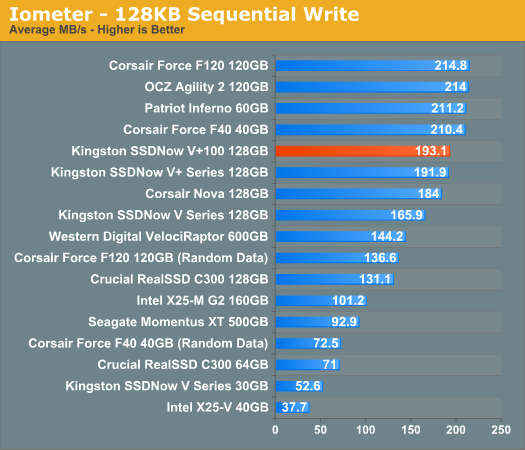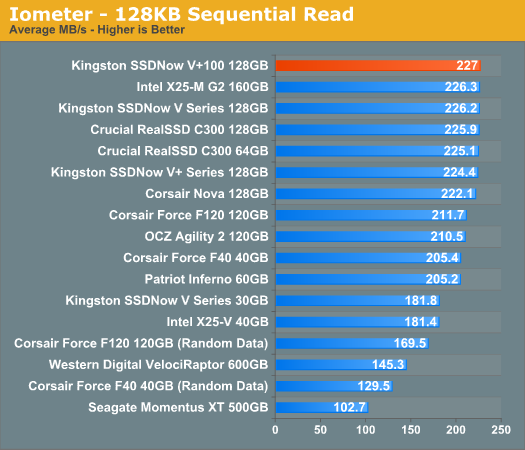Kingston SSDNow V+100 Review
by Anand Lal Shimpi on November 11, 2010 3:05 AM EST- Posted in
- Storage
- SSDs
- Kingston
- SSDNow V+100
Sequential Read/Write Speed
To measure sequential performance I ran a 3 minute long 128KB sequential test over the entire span of the drive at a queue depth of 1. The results reported are in average MB/s over the entire test length.

Sequential write speed is much higher than Kingston’s previous offerings. Compared to the old V+ there’s very little performance difference here. The new V+ 100 does well even against SandForce and Crucial based SSDs. In fact, if you write incompressible data to the SandForce drives the V+ 100 is the fastest SSD in sequential writes at this capacity.
The 64GB Crucial RealSSD C300 does a respectable 71MB/s here, which isn’t bad for a low capacity value drive. Sequential write speed is equal to Corsair’s F40 when writing incompressible data (e.g. compressed movies or pictures), and better than both the 40GB X25-V and 30GB Kingston SSDNow V Series.

The V+ 100‘s sequential read speed is excellent, just a hair above the top drives from Intel and Crucial. There’s not much room for improvement here unless you go to a 6Gbps interface. Although not displayed here, the Crucial RealSSD C300 on a 6Gbps SATA interface is the single-drive sequential read speed king.
The 64GB C300 loses no performance as a result of its lower capacity, making it the best low capacity drive for sequential read performance.
Overall Iometer shows us that the four corners of SSD performance are not dominated by any one controller/firmware combination. Crucial takes the clear lead in random read performance, while the Toshiba based SSDNow V+ 100 is the 3Gbps sequential read king. Random write performance depends mostly on what you’re writing. If you’re writing highly compressed data like movies and pictures, then Crucial is the undisputed champ there as well. If you’re writing documents, emails and other highly compressible data, SandForce based drives like the Corsair Force and OCZ Vertex 2 are the drives to beat.
With no silver bullet, we have to look at various desktop workloads to really measure the performance of these drives.










96 Comments
View All Comments
DanNeely - Thursday, November 11, 2010 - link
The 2xnm lifetimes will be shorter. The flash lifetime is a function of feature size, so as processes shrink lifetime will as well. At the same time, it's only likely to be a concern if you're doing very IO intensive activities. My 128GB Indilinx drive is at 96% after a year in my main desktop. At this rate I'll be nowhere near the maximum write limit when the flash dies of old age in another 4-9 years even if I keep it as my main drive the whole time which is doubtful.If scaling is linear with feature area, as the 50% drop in life-cycles from 50 to 34 nm implies, 22nm 2 level flash will last about 2500 write cycles. This still will probably be long enough not to matter. 14nm flash and beyond might not be unless they switch to SLC for consumer SSDs, and only use MLC for memory cards and thumb drives. With 10x the allowed number of write cycles SLC flash should remain good for several additional process shrinks.
OTOH that might be a moot point because the power levels needed to write flash doesn't drop with each process, and unless something changes flash is expected to hit a will in the teens because the wires on the chip won't be able to carry the load without melting.
Iketh - Thursday, November 11, 2010 - link
Anand, couldn't you just continue running your random write test 24/7 until it falls dead, or is this not feasible?Maybe it's not feasible with the Kingston drive because the random write performance is too slow? Which could bring up speculation that it's intentionally handicapped so this type of test is avoided?
Skiprudder - Thursday, November 11, 2010 - link
Hello Anand,Really interesting article as usual. I had no idea that there was such a gulf between various Sandforce controllers. There was one line however that perplexed me, "The V+ 100‘s sequential read speed is excellent, just a hair above the top drives from Intel and Crucial. There’s not much room for improvement here unless you go to a 6Gbps interface."
Why didn't you use a Sata 6 controller? I think that most of us buying boards today will be looking at Sata 6 since so many today's current SSDs clearly outstrip Sata 3, to say nothing of the upcoming 500MB/s and better drives coming down the pipeline. I'm sure you have a good reason, and I know there has been some weird controller issues with AMD I believe, but I'm very curious! Thank you.
Casper42 - Thursday, November 11, 2010 - link
Just saw this on Gizmodohttp://slickdeals.net/forums/showthread.php?t=2365...
Puts it at around $1.60/GB and if you skip past the synthetic benchmarks and look at AT Storage Bench, its a pretty formidable drive. Makes me a little sad I spent more than this on my 160 X25M G2 a while back.
BoboGO - Thursday, November 11, 2010 - link
The true cost vs. useability (usable nand) price breakdowns are as follows... I think... :)SSD Price Comparison - November 11, 2010
SSD Useability % Price $/GB of USEABLE NAND
Western Digital SiliconEdge Blue 93.13% $214.99 $1.80
Corsair Nova V128 128GB 93.13% $219.99 $1.85
Kingston SSDNow V Series 128GB 93.13% $224.99 $1.89
Corsair Force F120 120GB 87.34% $229.99 $2.06
OCZ Agility 2 120GB 87.34% $229.99 $2.06
OCZ Vertex 2 120GB 87.34% $234.99 $2.10
Crucial RealSSD C300 64GB 93.13% $134.99 $2.26
Crucial RealSSD C300 128GB 93.13% $269.99 $2.27
Kingston SSDNow V+ Series 128GB 93.13% $277.00 $2.32
Kingston SSDNow V+ 100 128GB 93.13% $278.99 $2.34
Intel X25-V 40GB 93.25% $ 94.99 $2.55
Patriot Inferno 60GB 87.34% $149.00 $2.67
Intel X25-M G2 160GB 93.13% $409.00 $2.74
Kingston SSDNow V Series 30GB 93.00% $ 82.99 $2.97
Corsair Force F40 40GB 77.71% $124.99 $3.35
SeetheSeer - Thursday, November 11, 2010 - link
Brilliant...just needs controller info added. I think I'll do some searching later tonight if I have time.Is total capacity listed in GB (10^9) or GiB(2^30)? What about usable capacity? I wish people paid more attention to this, especially in area such as this were flash storage (typically in GiB) is being used for a drive (typically in GB).
SeetheSeer - Thursday, November 11, 2010 - link
Anand,Do you think a short description of which controller each drive uses could be added to the table on page 2? It seems to me that it would be much more instructive to sort the drives based on this, rather than the often rebadged brand.
Out of Box Experience - Sunday, November 14, 2010 - link
How about this info when comparing SSD's? >1. Is it truly Plug and Play on any OS?
2. Does it have Alignment Agnostic Controllers?
3. Does it handle incompressible Data really well under XP?
Since the majority of computers still run XP, this information is the most valuable to the most people
snakyjake - Thursday, November 11, 2010 - link
There's a lot of stats for the drives, however I'm not any closer in choosing a drive.I have 3 systems:
1. Windows 7. This system is mostly lots of opened web browsers hogging memory, email, maybe a Word document, video encoding, and reference software (i.e. encyclopedia). I assume the browser is caching to the drive, same with the virtual memory and other background apps. I don't turn the machine off, so boot time is not important. For video encoding, I'd like to keep the data on a HDD since it is a lot of storage that SDD's are not affordable at storing, and it is most likely CPU bound.
2. Media Center. Want a SDD for the main drive (OS and apps), but will use a larger/slower drive for the media storage. Need something low heat. This is what I really want a SDD for.
3. Linux. Mostly emailing and web browsing. All the apps I use are cloud apps.
Obviously the fastest drive would be the one I want if money is no object. But I want to know how much faster my experience is going to be for how much more money? My goal is a snappy system and less time waiting around. I want to know what I'd sacrifice by getting a "value" drive versus the higher quality.
Also, MTBF is important. I hate losing data! Hope the drives have SMART or some other methods of warnings.
Thanks,
Jake
Out of Box Experience - Thursday, November 11, 2010 - link
If all you want to do is boot up quickly and load your apps really fast, then a sandforce drive is perfect for youIf you want to manipulate data already on the drive or copy & paste to the same drive, then you are much better off with a 7200RPM desktop drive as far as I can tell
Anyone wanting to spend their time doing actual work instead of constantly tweaking their SSD to get synthetic benchmarks that have little bearing on real world results should avoid sandforce based drives like the vertex 2
Please read my other posts in this thread for more info